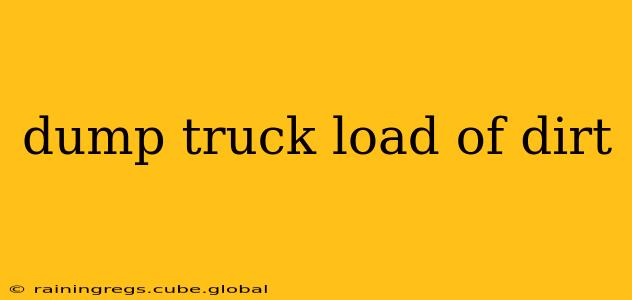Getting a dump truck load of dirt might seem simple, but understanding exactly how much material you're getting can be crucial for various projects, from landscaping to construction. This guide will delve into the specifics of dump truck capacity, factors affecting load size, and how to ensure you get the right amount of dirt for your needs.
What is the average weight of a dump truck load of dirt?
The weight of a dump truck load of dirt varies significantly depending on several factors. The truck's size (which dictates its capacity) is the primary determinant. Smaller trucks might carry a few tons, while larger models can haul upwards of 20 tons or more. The type of soil also plays a role; denser soils will weigh more per cubic yard than lighter, more porous soils. Finally, the method of loading influences the final weight – a loosely loaded truck will weigh less than one packed tightly.
Therefore, there isn't a single definitive answer to this question. You'll need to specify the truck size and type of soil to get an accurate estimate. However, as a rough guideline, a standard dump truck load might range from 10 to 25 tons of dirt, depending on the factors mentioned above.
How many cubic yards are in a dump truck load of dirt?
Similar to weight, the cubic yardage of a dump truck load depends on the truck's size and how it's loaded. Dump trucks are typically measured in cubic yards, with capacities ranging from 10 to 20 cubic yards for common models used in landscaping and smaller construction jobs. Larger trucks used in heavy construction projects can carry considerably more.
It's important to remember that a "heaped" load – where the dirt is piled above the truck's sides – will contain more cubic yards than a "level" load, where the dirt is even with the truck's sides. Always clarify with the hauler whether the quoted volume is heaped or level.
How much does a dump truck of topsoil cost?
The cost of a dump truck load of topsoil (or other types of dirt) is highly variable. Factors influencing the price include:
- Location: Transportation costs play a significant role. Delivery further distances will increase the final price.
- Type of soil: Premium topsoil blends or specialized soils will cost more than standard dirt.
- Quantity: Bulk discounts are often available for larger orders.
- Demand: Seasonal fluctuations or high local demand can also impact pricing.
To obtain an accurate price quote, contact local landscaping companies or soil suppliers directly. Requesting multiple quotes is recommended to compare prices and services.
What size dump truck do I need for my project?
Choosing the right dump truck size requires careful estimation of your project's material requirements. Accurately calculate the volume of dirt needed for your landscaping, foundation, or fill work. Consider factors such as:
- Project size: A larger project naturally needs a larger truck.
- Accessibility: Narrow driveways or restricted access may limit the size of the truck that can deliver.
- Site preparation: Ensure the delivery area can accommodate the truck's size and weight.
Start with your project's cubic yard requirements, then contact dump truck services to determine the most appropriate truck size for your specific needs and site conditions. Remember to always confirm the truck's capacity – both in cubic yards and weight – before scheduling delivery.
What are the different types of dump trucks?
Dump trucks come in a variety of sizes and configurations, each designed for different applications. These vary from smaller, single-axle trucks suitable for lighter loads to larger, heavy-duty models capable of transporting massive quantities of materials. Some common types include:
- Single-axle dump trucks: Smaller, often used for lighter landscaping or smaller construction projects.
- Tandem-axle dump trucks: Larger capacity, suitable for medium-sized projects.
- Tri-axle dump trucks: Largest capacity trucks, ideal for major construction and heavy-duty hauling.
Understanding these differences helps determine the appropriate size needed for your project's dirt requirements.
By considering these factors and contacting local suppliers for accurate quotes, you can confidently acquire the right amount of dirt for your project, ensuring efficient and cost-effective completion.
